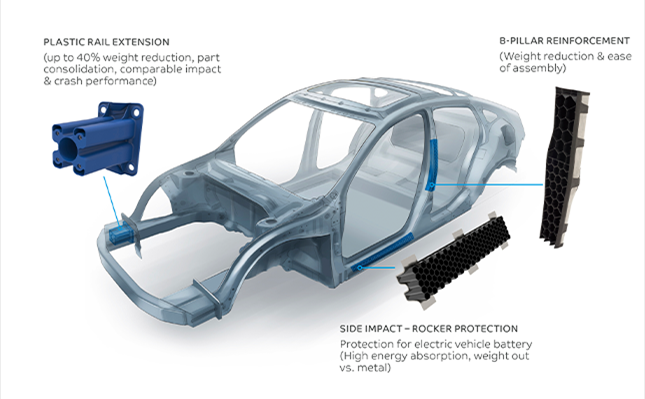
Crash and Chassis
The growing adoption of EVs has intensified consumer and OEM focus on vehicle safety. Protecting lithium-ion batteries from side impacts is just one of the latest additions to the automotive industry’s long history of safety initiatives. Vehicles incorporate energy absorbing structures and reinforcements to protect occupants and pedestrians and comply with regulations. However, these structures can add weight that detracts from fuel economy, limits EV range and affects emission reduction goals.
SABIC’s NORYL GTX™ resins support customers in their efforts to enhance crash & impact safety. By helping enable designs that include metal/plastic hybrid structural components, it becomes possible to reduce weight compared to metal alone, while delivering excellent dimensional and hydrolytic stability and low-temperature ductility for optimal energy absorption. Low-density NORYL GTX resin solutions are up to 20% lighter than other thermoplastics and up to 40% lighter than steel. For ease of manufacturing, they are e-coat capable and can withstand temperature extremes during assembly.
NORYL GTX resins can be used in hybrid structures that can incorporate honeycomb configurations with a high strength-to-weight ratio. These materials are well suited for the side impact protection of EV batteries, A- and B-pillar reinforcements and roof reinforcements.
Featured Product Brands
|
NORYL GTX™ Resins |
Modified polyphenylene ether (PPE) resins with polyamide offering dimensional stability, low density, and good hydrolytic, chemical, temperature and creep resistance. |
Body-in-White (BIW) Structures
NORYL GTX resins address current trends for BiW reinforcements and crash protection components, including reducing weight and package space. These resins can be used to mold strong, lightweight honeycomb structures used in hybrid plastic/metal BiW components, such as rocker, B-pillar, and rail extensions members, because this approach makes the best use of available space and delivers superior energy absorption.
In applications such as roof and floor crossbar beams, bumper systems and seat frame structures, NORYL GTX resins offer performance advantages over other thermoplastics such as PBT (hydrolytic and dimensional stability) and PA (dimensional stability). These solutions can deliver energy absorption performance comparable to that of high-strength steel. Low density allows NORYL GTX resins to reduce weight and mass vs. metal and other thermoplastics to support sustainability and design goals.
EV Battery Crash Protection
A crash or other impact that damages an EV’s lithium-ion battery can pose risks of thermal runaway that can lead to fire or explosion. To prevent or mitigate this risk, as well as exposure to toxic chemicals from the battery, side protection is used to absorb kinetic energy from a collision and keep the battery pack intact. NORYL GTX resins can be used in hybrid metal/plastic side impact protection. Designs may incorporate thermoplastic honeycomb structures overmolded onto metal flanges, which are direct welded to the rocker panel. This approach offers part consolidation, reduced secondary operations and potential cost-out, while delivering excellent energy absorption.
